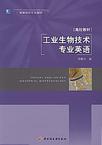工业生物技术专业英语
出版时间:2009-4 出版社:中国轻工业出版社 作者:许赣荣 编 页数:215
Tag标签:无
前言
第一版《发酵生物技术专业英语》于1996年出版以来,已有13年了。在此期间,生物技术得以大力发展。人类基因组计划的初步完成,使生物医药行业正经历着巨大的变化;食物和能源的需求促进了农林业及能源领域中生物技术的飞速发展;全球经济发展也带来了生态环境的恶化、生物多样性的破坏,使生物技术对环境生态的保护作用得以充分地体现。这些巨大的变化都使第一版《发酵生物技术专业英语》在选题内容及形式上应有所更新及丰富,以适应时代发展的变化。为此,编者以第一版《发酵生物技术专业英语》为原型,在内容及形式上作了较大幅度的调整,编成此书。 1.书名更换 本教材的名称以《工业生物技术专业英语》代替《发酵生物技术专业英语》,主要是因为“发酵工程(或工业发酵)”这一名称已逐渐被“工业生物技术”所取代。“工业生物技术”可以从两方面理解:应用工业化技术实现生物技术的目标;生物技术在工业上的应用。生物技术是一门庞大的学科,从应用的角度看,生物技术广泛应用于医药行业、农业(农作物、林产、畜牧业)、工业(工业发酵)等领域。虽然这种分类方法并不是科学的分类,但在课文内容上还是按照大家约定俗成并有所界定的工业生物技术领域进行选题。 2.课文内容的更新 本教材是以《发酵生物技术专业英语》为基础写成的。原教材有正文(Text A、Text B)32篇,阅读材料22篇,论文2篇。新版教材做了较大的调整,但为使本课程的教学保持基本稳定,每课(Lesson)中至少保留一篇原书的课文。具体的变更如下: 《工业生物技术专业英语》教材中正文仍为32篇,其中18篇来自原教材,换新正文(包括标题和内容)14篇。部分课文的顺序和原教材有所变动。新教材中阅读材料由22篇增至32篇。其中新增或换新阅读材料19篇。论文仍为2篇。新增专利文献资料一份。第1课至第4课,Text A和Text B均有参考译文,从第5课起,仅Text A有参考译文。Text B可作为学生练习翻译之用。阅读材料可作为快速阅读或翻译用。 课文的专业内容,以工业生物技术(原发酵生物技术)为主。分为基础类课程内容(如无机化学、有机化学)、专业基础课程内容(如生物化学、微生物学、分子生物学)、专业课程内容(发酵工程上中下游技术、发酵设备和生物技术的应用等)三个方面。 新教材中,换新或新增的课文和阅读材料所选择的文章充实了更多的专业词汇,专业内容也更加丰富和全面。但根据学生的知识结构,这些课文内容专业知识的深度定位于大学本科阶段,同时也适合研究生等对工业生物技术专业英语要求较高的层次。根据上述要求,每课中的Related Words and Expressions中的词汇量有所增加。
内容概要
本教材共16课,每课有正文(A、B两篇独立的课文),阅读材料(两篇),补充资料和练习四大部分。最后还安排了附录,收录了英汉微生物名称、国际上有关生物技术的期刊名称。 在课文内容上,主要选择了有关生物技术(偏重于发酵工程)的内容,包括以下专题:无机化学,有机化学,分析化学,生物化学(糖、蛋白质、核酸),微生物学(菌种、操作方法),分子遗传学,代谢,酒(啤酒、葡萄酒、威士忌),生物能源,动植物细胞培养,干细胞培养,抗生素,药品的临床评价等药学内容,环境生物技术,发酵动力学,生化反应器(液态及固态发酵罐),分离纯化等下游技术,化学分析方法,论文(摘要、前言、材料与方法)。在最后,还安排了英语论文两篇、专利。每篇课文均有补充资料,如补充的专业词汇、构词法、翻译理论与技巧、CA缩略语精选、写作句型句例。课文中的大多数专业词汇还注有音标。 本书可作为工业生物技术专业(发酵工程或生物工程)高校及大专中专学生的专业英语教材,由于在内容上有所拓展,故也适应于发酵工厂或研究所的有关技术人员参考。
书籍目录
Lesson 1 Text A Elements and Compounds Text B Atomic Bonds and Molecules Reading Materials ( Ⅰ ) Water as a Solvent Reading Materials ( Ⅱ ) True-False Questions Additional Information ExercisesLesson 2 Text A Nomenclature of Alcohols Text B Carbohydrates Reading Materials ( Ⅰ ) Amino Acids Reading Materials ( Ⅱ ) The Plant Kingdom Additional Information ExercisesLesson 3 Text A The Tricarboxylic Acid Cycle: A Carbon and Energy Wheel Text B Induction and Feedback Repression Reading Materials ( Ⅰ ) Toluene Biodegradation Pathways Reading Materials ( Ⅱ ) Regulation of Branched Metabolic Pathway Additional Information ExercisesLesson 4 Text A Nucleotides and Nucleic Acids Text B Proteins Reading Materials ( Ⅰ ) Macromolecules Reading Materials ( Ⅱ ) Assay Procedure for Protein Concentration Additional Information ExercisesLesson 5 Text A Enzymes Text B Hydrolytic Enzymes Reading Materials ( Ⅰ ) Cattle Feed Enzymes and Probiotics Reading Materials ( Ⅱ ) Inhibition of Enzyme Activity and Immobilized Enzymes Additional Information ExercisesLesson 6 Text A Microorganisms and Viruses Text B Introduction to Microbiology Reading Materials ( Ⅰ ) Cell Quantification Reading Materials ( Ⅱ ) Maintenance and Storage Additional Information ExercisesLesson 7 Text A Gene Cloning in Bacteria Text B Gene Control in Prokaryotes Reading Materials ( Ⅰ ) Quality of the DNA Vaccines Reading Materials ( Ⅱ ) Selection of Mutagens Additional Information ExercisesLesson 8 Text A Conventional Batch Fermentation Processes for Ethanol Production... Text B Batch and Continuous Processes Reading Materials ( Ⅰ ) Various Phenomena That Occur Within SSF Bioreactor Reading Materials ( Ⅱ ) Oxygen Transfer Additional Information ExercisesLesson 9Lesson 10Lesson 11Lesson 12Lesson 13Lesson 14Lesson 15Lesson 16Paper1Paper2US PatentAppendix习题参考答案参考文献
章节摘录
A less common but more sustainable method of waste disposal is anaerobic digestion. In this process waste decomposes in an enclosed chamber, unlike in a landfill site. Digestion takes place in an oxygen-freet environment. Bacteria thrive in this environment by using the oxygen that is chemically combined within the waste. They decompose waste by breaking down the molecules to form gaseous by-products ( methane ) and small quantities of solid residue. Anaerobic sewage plants produce significant quantities of methane, which can be burnt to generate electricity. Liquid and solid organic fertilisers are also formed, and can be sold to cover operating costs. For several years, sewage sludge and agricultural waste has been treated by anaerobic digestion, and the process is now being used for municipal solid waste. It requires the biodegradable section of the waste to be separated from other material and put into digestion chambers. Currently, the UK has only a small number of plants, and each can handle only a few hundred tonnes of waste each year. However, the usage of anaerobic digestion as a sustainable waste disposal method is forecast to increase. Many other countries already utilise anaerobic digestion to dispose of large amounts of waste. Denmark for example, treats 1.1 million tonnes of waste by anaerobic digestion every year. As well as recycling waste, individuals can adopt more sustainable ways of disposing it. One way is to compost any organic waste such as food and garden waste. Organic waste breaks down over a few weeks into a mulch which can be used as a soil fertiliser. Individual households have practiced small-scale composting for many years, and the UK Government is now encouraging this on a wider scale. Large-scale composting schemes are also being developed, with the collection of organic waste from parks and civic amenity sites. Garden and food wastes are collected directly from households in separate kerbside collections. Large central facilities can then compost the collected organic waste. These schemes are to help the UK meet its target of recycling and composting 33% of household waste by 2015.
图书封面
图书标签Tags
无
评论、评分、阅读与下载
用户评论 (总计9条)
- 我一直再找关于工业生物技术专业英语的书,这本书很合适,特别对发表外文文章很有益。
- 是生物专业英语的好教材
- 与第一版比,改进了好多,词汇加了音标,很好啊!
- 书的质量很好,很好,很满意。
- 书不错,正认真看呢
- 同事出国准备的,用着还行吧
- 是正版的,质量不错,就是太白了,有点闪眼
- 书写的不错,适合初学者
- 没看到实物,应该不错吧。
